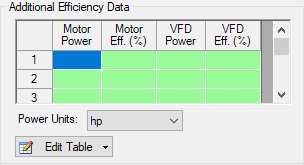Compressor/Fan Efficiency Data
Note: All efficiency data in the Compressor junction is treated as an isentropic efficiency.
Best Efficiency Point (BEP)
By defining a power or efficiency curve, the Best Efficiency Point of the compressor/fan can be found. Optionally, the calculated value can be overridden with a user-defined value on the Configuration Data tab on the Compressor/Fan Configuration window. It is generally desirable to operate compressors/fans as close to the BEP as possible. The Compressor/Fan Summary can display what the BEP is, as well as how far off (in % of BEP) of BEP the compressor/fan is operating in the model.
Nominal Efficiency
When modeling a fixed flow or fixed rise compressor/fan, you can optionally input a nominal efficiency as an approximation. This can be useful for sizing or design purposes, although more precise efficiency data should be entered when modeling a compressor/fan curve.
Power and Efficiency Calculations
Various stages of power or efficiency data relating to a compressor assembly can be added to a compressor junction.
The most basic value that can be accounted for is the compressor efficiency or power curve. This curve, entered in Compressor Configuration when the Centrifugal Compressor model is chosen is used to determine the power/efficiency being delivered to the compressor itself - the Shaft Power.
AFT Arrow uses the compressor curve with the system configuration to determine the total pressure rise (Δp = p2 - p1) and flow (Q) through the compressor. The isentropic power used at the compressor/fan can be calculated using the stagnation pressure values, volumetric flow, and isentropic expansion coefficient (k) as given by the following equation from Perry, 10-39 (1997)Perry, R. H., Green, D. W., Perry's Chemical Engineers' Handbook, 7th Edition, McGraw-Hill, New York, NY, 1997.:
Where power is in hp, flow is in ft3/min, and pressure is in psia. Alternate forms of the above equation can be found in Perry.
Note: In Arrow's interface gamma (γ) is used to represent the isentropic expansion coefficient instead of k.
With a compressor power or efficiency curve, the missing value can be calculated with the curve value at the given flow:
Note the compressor efficiency value used here is the isentropic efficiency.
On a compressor's optional tab, further efficiency information can be defined:

Figure 1: Additional Efficiency Data
Entries in this table must come in pairs - both Power and Efficiency values must be present for a calculation to take place, but only one pair is required. That is, only Motor data or only VFD data can be entered in addition to filling out all four columns.
Motor Power in this instance refers to the output power of the motor - the Shaft Power calculated previously, delivered to the compressor. Because the Shaft Power is already known, the Motor efficiency can be looked up from this table. Motor Input Power can then be calculated:
VFD Power is used in a similar fashion. The VFD Power in Figure 1 refers to the Output power of the VFD, which is identical to the Motor Input power. Because Motor Input Power was calculated, VFD efficiency can be looked up in the table, and VFD Input Power calculated with:
This power is considered the Overall Power, viewable in the Compressor Summary along with all of the other above values. Whenever an efficiency value is left undefined, it is assumed to be 1 (perfectly efficient).



